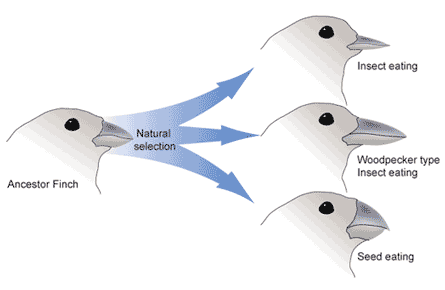The Theory of Evolution by Natural Selection is the only known process able to accurately explain the diversity of life that accounts for all the observable evidence. Evolution by natural selection was discovered simultaneously by Charles Darwin and Alfred Russell Wallace in the middle of the 19th century and was jointly presented to the Linnean Society on July 1, 1858. Charles Darwin historically receives a bulk of the credit for this revolutionary discovery, justifiably, as he published a comprehensive book, On the Origin of Species, one year later that contained abundant documentary evidence to support his conclusions.
Despite the incredulity of some people, the process of natural selection is remarkably simple to understand. Variations among individuals exist within a population of species and as a result each individual interacts with their environment slightly differently. Some individuals will necessarily be suited slightly better or slightly worse in relation to others to survive and reproduce in their particular environment. Those suited slightly better will survive longer (at least long enough to reproduce) and reproduce more, passing those slightly better characteristics on to their offspring, who in turn will reproduce more. Those suited slightly worse will not survive as long (or not even long enough to reproduce) and reproduce less offspring. Eventually those characteristics favorable to survival and reproduction will come to predominate the population, and the species will have evolved. Characteristics could be the color of a bird, or they could be the size and shape of its beak, the design of its wing, the shape of its eye, or anything else that would aid in survival and reproduction. This process of differential survival and reproductive success is called natural selection.
“The ideas behind natural selection were that there was such a thing as a hereditary material, that there were spontaneous changes in the hereditary material, that those changes were expressed in the external form and function of the organism, that organisms made many more copies of themselves than the environment could support, and therefore that some selection among various natural experiments was mad by the environment for reproductive success, that some organisms, by pure accident, were better suited to leaving offspring than others.” – Carl Sagan
Evolution by natural selection has been called “decent through modification” and it works like an algorithmic process. Algorithms are logical rules that if followed will yield a certain result. If certain conditions are meant, by means of an underlying mindless process, the results are guaranteed. Long division is a simple example of an algorithmic process, as are all computer programs. Darwin’s algorithm goes as such:
- 1) Heredity: Characteristics of organisms are passed onto decedents, but with slight variations – no two organisms are exactly alike
- 2) Competition: There is competition and a struggle for life.
- 3) Selection: Those decedents with advantageous variations – any that help one survive and reproduce – will out-reproduce all others, and their characteristics will then become commonplace within the population
- 4) Repeat: These slightly modified decedents are organisms capable of having children, so repeat step 1
Naturally, some people still will read this and be inclined to reject the notion that evolution occurs in nature. Thankfully, there is an overflowing wealth of evidence available to support the theory.
Further reading: Climbing Mount Improbable by Richard Dawkins; The Blind Watchmaker by Richard Dawkins; Darwin’s Dangerous Idea by Daniel Dennett
